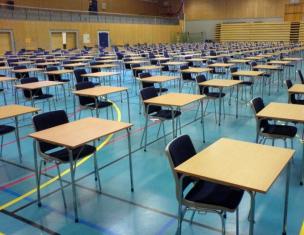Page 16 of 40
NETWORK OF STREETS AND ROADS
6.17. Street and road network settlements should be designed as continuous system taking into account the functional purpose of streets and roads, the intensity of transport, cycling and pedestrian traffic, architectural and planning organization of the territory and the nature of the development. The road network should include streets and roads of main and local significance, as well as main streets. Categories of streets and roads in cities should be assigned in accordance with the classification given in Table. 7.
Another very effective method encouraging root growth opposite side sidewalk is to occupy several holes with a very long drill under the sidewalk while planting. One to two inch diameter holes start at the bottom of the planting hole and extend through the compacted soil under the sidewalk. One option is to make a series of holes with a steel rod driven under the pavement with a hammer and pulled back out. At the end of the hole, the root will expand into better, less compacted soil.
The hole should not be filled with anything, so the tree root will grow through the hole during one growing season. A curb light, also called a sidewalk curb, is a large projection of sidewalk at city street intersections. It is intended to provide a shorter walking path for pedestrians walking across the street and encourage drivers to slow down due to the narrower intersecting street. In some situations, trees may be planted within the bulb area to provide a larger area of soil suitable for tree root growth.
6.18*. The design parameters of city streets and roads should be taken according to table. 8*, rural settlements - according to table. 9.
6.19. The distance from the edge of the main carriageway of highways to the residential development control line should be taken to be at least 50 m, and, subject to the use of noise protection devices that meet the requirements of SNiP II-12-77, at least 25 m.
Projects that include trees and landscaping must ensure that sightlines are maintained correctly. Moving the curb will not work if there are problems with drainage and other infrastructure. Transportation issues may also prohibit the use of lamps. Other street uses may be planned for the existing roadway width, such as bicycle and pedestrian facilities.
Adjusting the terrain involves moving the location of the curb a significant distance, such as along an entire block, to widen the planting strip and provide more space for trees. This requires space in the right-of-way to create additional width in the planting strip, taking space away from traffic and the street.
The distance from the edge of the main roadway of streets, local or side drives to the building line should be no more than 25 m. In cases where this distance is exceeded, a 6 m wide strip suitable for the passage of fire engines should be provided at a distance of no closer than 5 m from the building line.
6.20. At the end of the roadways of dead-end streets and roads, areas with islands with a diameter of at least 16 m for turning cars and at least 30 m in diameter when organizing a final point for turning around public passenger transport should be constructed. The use of turntables for parking vehicles is not permitted.
Such efforts are typically carried out as part of large-scale street repair or reconstruction operations, such as the overhaul or the Streets Project to provide additional space for new trees, provide a pedestrian friendly environment and improve traffic flow. Boundary adjustments will require traffic and engineering studies due to other impacts on parking, transit and other transportation.
Curbs, streets and sidewalks can be designed to go around existing trees to increase the distance from the tree to the edge of the sidewalk. This can be done by either narrowing the sidewalk or rerouting it around the tree. This method slows downward movement and keeps the tree healthy because the roots do not need to be cut. These locations also provide an opportunity to enhance the landscape with additional trees, shrubs and flowers. This effort also protects the existing tree, especially if the tree is of high value.
6.21*. On main streets with regulated traffic, it is allowed to provide bicycle paths separated by dividing strips. In public recreation areas and other green areas, bicycle paths should be provided, isolated from streets, roads and pedestrian traffic. Bicycle paths can be arranged for one-way and two-way traffic at the shortest safety distance from the edge of the bike path, m:
The offset can be combined with an easement to locate a sidewalk on private property adjacent to the right of way. An easement can provide more space for existing or new trees. The width of the easement is determined by the site. This is useful if sufficient planting space is not available in the right-of-way.
Curbs are often replaced when roads are resurfaced, especially if they are damaged or not high enough. The following alternatives will reduce the amount of root damage during the replacement process. The excavation bucket should be only 12 inches wide to allow space for creating molds, stone, or operating a shoe machine. The sidewalk can be shredded using a milling machine so that a new layer of sidewalk can be installed without touching the curb, leaving the curb exactly as it was. The bead can be removed and replaced at a higher height or location. . A favorite of many communities in suburban locations, when practical, redeveloping areas for sidewalks and grass strips to reduce the need for root crops and provide more space for new trees and where there is higher, unconstrained soil area.
to the roadway, supports, trees...................... 0.75.
to the sidewalks........................................ .......... 0.5;
to car parks and bus stops
public transport. ................................. 1,5.
Note. It is allowed to install bicycle lanes along the edges of the carriageway of streets and roads, marking them with a double line. The width of the lane must be at least 1.2 m when moving in the direction of traffic flow and at least 1.5 m when moving in oncoming traffic. The width of the bicycle lane installed along the sidewalk must be at least 1 m.
If your tree lawn is less than 3 feet wide, use this option to plant trees on private territory or near it at least 3 feet from the sidewalk. While cities may require state trees to grow on public property, some cities will allow seedings on private property to be maintained by the property owner rather than at city expense.
With trees near or on private property, the roots have plenty of room to develop in lawn areas. The trees are healthier and they grow faster than a tree next to the street. Research has shown that a tree planted behind a sidewalk will reach a street canopy equal to or faster than a single tree planted next to the street on a narrow lawn.
6.22*. The radii of curvature of the carriageway of streets and roads along the edges of sidewalks and dividing strips should be taken at least, m:
for main streets and roads
controlled movement................................... 8
local significance............................................. 5
at transport areas............................................. 12
In cramped conditions and during reconstruction, the radii of curvature of main streets and controlled traffic roads can be reduced, but taken at least 6 m, in transport areas - 8 m.
This planting eliminates trees that may suffer from exhaust fumes, damaged trunks and vehicle damage. In addition, damage from straw and snow is eliminated. Roots should not grow in poor quality, compacted soil in very confined spaces. In addition, there are fewer conflicts with overhead and underground utilities. All of these factors result in better tree growth, longer lifespans, and lower city maintenance costs.
This option is not possible in the city center or in highly developed areas where there is no existing soil suitable for tree root growth. Elevation changes can be used to provide spatial separation between the finished tree pit grade and the surrounding sidewalk or other surface. This approach will prevent compaction of the soil around the firewood.
In the absence of a curb fence, as well as in the case of using minimum radii rounding, the width of the carriageway of streets and roads should be increased by 1 m for each lane due to side dividing strips or widening with outside.
Note. For public transport (tram, trolleybus, bus), the radii of curvature are set in accordance with technical requirements operation of these types of transport.
When a tree is growing in a raised or lowered position, attention to water issues becomes very important. Too much water from a root outbreak located under a street, curb or sidewalk may be a concern, along with these areas tend to accumulate debris and debris and may be more difficult to access. Tree grates or other materials may provide a passable surface level by adjacent varieties above the sunken pit area. Planting methods and details can be similar to planting trees in decomposition planters so that stormwater can flow into them.
6.23*. At uncontrolled intersections and junctions of streets and roads, as well as pedestrian crossings, it is necessary to provide visibility triangles. The dimensions of the sides of an isosceles triangle for the "transport-transport" conditions at a speed of 40 and 60 km/h must be, respectively, no less than: 25 and 40 m. For the "pedestrian-transport" conditions, the dimensions right triangle visibility should be 8x40 and 10x50 m at vehicle speeds of 25 and 40 km/h, respectively.
The design should provide drainage in recessed planting areas to avoid prolonged soil saturation. When a tree is growing in an elevated area, lack of water can become a problem. Raised trees may need to be surrounded by containment to prevent soil erosion.
Manipulation of existing sidewalks. Most of these manipulations are short-term solutions and should not be used if the pavement is more than 1 inch out of line with the adjacent panel. There is a limit to how much manipulation can be done at each point on the pavement based on the thickness of the pavement and the severity of the misalignment. The durability of the fixation will depend on how quickly the additional raising or lowering of the pavement occurs. These types of repairs rarely fix the problem long-term, but they do reduce travel hazards for pedestrians until a permanent solution can be made.
Within the visibility triangles, the placement of buildings, structures, mobile objects (kiosks, vans, advertisements, small architectural forms etc.), trees and shrubs more than 0.5 m high.
Note. In the conditions of the current capital development, which does not allow organizing the necessary visibility triangles, the safe movement of vehicles and pedestrians should be ensured by means of regulation and special technical equipment.
Bending, shaving or sanding involves cutting away the raised edge of a concrete panel to create a smoother transition and reduce the risk of tripping. The concrete is beveled using a specialized cutting machine. Although this fix is less expensive in terms of labor time, it is typically limited to slabs with minor movement.
If one slab has settled more than one inch, a ramp can be installed on the adjacent bottom slab. The ramp should conform to the top plate as closely as possible to avoid other pedestrian safety issues. Temporary fixes consist of using wood, asphalt or concrete ramps to connect above the bottom slab to match the height of the top slab created by the problematic root or unstable soils. If the sidewalk is made of asphalt, which is flexible, root expansion will only occur in the area of the root itself.
6.24. In residential areas, in places where homes for the elderly and disabled, healthcare institutions and other institutions of mass visitation by the population are located, pedestrian paths should be provided with the possibility of passing mechanical vehicles. wheelchairs. In this case, the height of vertical obstacles ( side stones, curbs) along the route should not exceed 5 cm; steep ones are not allowed (more than 100 % O) short ramps, as well as longitudinal slopes of sidewalks and pedestrian roads of more than 50 % O. On tracks with slopes of 30-60 % O It is necessary to arrange horizontal sections at least 5 m long at least every 100 m.
The opposite process of building a ramp is to bevel the raised slab. If the sidewalk has moved and one slab is higher than the other, there is another option to correct the problem. By drilling a hole in the bottom slab, concrete slurry can be pumped under the slab to raise it with the adjacent slab. Grout is a mixture of cement and soil that is pumped under pressure below the existing concrete panel. The practice can also be done using foam filling material.
The mixture fills the void below the surface and adds additional support under the concrete panel. This option works well if there is only one section of sidewalk that needs to be replaced and the concrete panels remain in good condition. Special equipment is needed to drill a hole in the concrete panel and another machine to pump the solution.
Table 7
| The main purpose of roads and streets |
|
| Main roads: | |
| high-speed traffic | High-speed transport links between remote industrial and planning areas in the largest and largest cities: exits to external car roads, to airports, large public recreation areas and settlements in the settlement system. Intersections with main streets and roads at different levels This option should not be used if there is an existing tree whose roots would be seriously damaged by this process. Additionally, it is not economically feasible to make only one slab of pavement at a time. Pavers or wedges are temporary measures to treat cracks or settlements in pavements to reduce the risk of disconnection and improve accessibility. They are similar to the rates over a longer period. Asphalt is commonly used to create pavement. Gaskets are used in response to a problem that needs to be corrected immediately. |
| controlled movement | Transport connections between city districts in certain directions and areas of predominantly freight traffic carried out outside residential buildings, exits to external highways, intersections with streets and roads, usually at the same level |
| Main streets: Gaskets are considered a temporary measure and require more frequent attention and repair or replacement than a completely repaired sidewalk. Expansion joints are transverse joints used to move concrete pavements due to temperature changes and changes in ground level. The standard spacing for expansion joints on sidewalks is a maximum of 28 or 30 feet. When the sidewalk is installed, use a continuous expansion material in the concrete, so as expansion and contraction occurs, any failure of the sidewalk will be absorbed by the expansion material. | |
| of citywide significance: | |
| continuous movement | Transport links between residential, industrial areas and community centers in the largest, largest and big cities, as well as with other main streets, city and external roads. Ensuring traffic flow in main directions at different levels |
| controlled movement | Transport connections between residential, industrial areas and the city center, centers of planning areas; exits to main streets and roads and external highways. Intersections with main streets and roads are usually at the same level |
| regional significance: | |
| transport and pedestrian | Transport and pedestrian connections between residential areas, as well as between residential and industrial areas, public centers, exits to other main streets |
| pedestrian and transport | Pedestrian and transport connections (mainly public passenger transport) within the planning area |
| residential streets | Transport (without passing freight and public transport) and pedestrian connections on the territory residential areas(neighborhoods), exits to main streets and controlled traffic roads |
| streets and roads in scientific-production, industrial and municipal-warehouse areas (districts) | Transport connections of mainly passenger and freight transport within zones (districts), access to main city roads. Intersections with streets and roads are arranged at the same level |
| pedestrian streets and roads | Pedestrian connections with places of employment, institutions and service enterprises, including within public centers, recreational areas and public transport stops |
| park roads | Transport connections within the territory of parks and forest parks mainly for the movement of passenger cars |
| Access of vehicles to residential and public buildings, institutions, enterprises and other urban development objects within districts, microdistricts, blocks |
|
| bike paths | Travel by bicycles or routes free from other types of traffic to recreational areas, public centers, and in the largest and largest cities communication within planning areas |
| Notes: 1. Main streets, as a rule, are distinguished from transport-pedestrian, pedestrian-transport and pedestrian streets and are the basis of the architectural and planning structure of the city center. 2. Depending on the size and planning structure of cities, traffic volumes, the indicated main categories of streets and roads may be supplemented or their incomplete composition used. If the estimated time spent on labor movements exceeds those established by these standards, it is allowed, if there are special justifications, to accept the categories of main streets and roads given in this table for groups of cities with a larger population. 3. In conditions of reconstruction, as well as for streets of district significance, it is allowed to construct highways or sections thereof intended only for the passage of public transport with the organization of tram-pedestrian, trolleybus-pedestrian or bus-pedestrian traffic. 4. In historical cities, it is necessary to provide for the exclusion or reduction of the volume of ground transport traffic through the territory of the historical core of the city center: the construction of bypass main streets, streets with limited traffic, pedestrian streets and zones; placement of parking lots mainly around the perimeter of this core. |
|
Table 8*
| Design speed, km/h | Width of traffic lane, m | Number of lanes | Smallest radius of curves in plan, m | The largest longitudinal slope, % O | Width of the pedestrian part of the sidewalk, m |
|
| Main roads: | ||||||
| high-speed traffic | ||||||
| controlled movement | ||||||
| Main streets: | ||||||
| of citywide significance: | ||||||
| continuous movement | ||||||
| controlled movement | ||||||
| regional significance: | ||||||
| transport and pedestrian | ||||||
| pedestrian and transport | ||||||
| Local streets and roads: | ||||||
| residential streets | ||||||
| streets and roads of research and production, | ||||||
| industrial and municipal warehouse areas | ||||||
| park roads | ||||||
| basic | ||||||
| minor | ||||||
| Pedestrian streets: | ||||||
| basic | By calculation | According to the project |
||||
| minor | ||||||
| Bicycle paths: | ||||||
| isolated | ||||||
| isolated |
* Taking into account the use of one lane for parking cars.
Notes*: 1. The width of streets and roads is determined by calculation depending on the intensity of traffic and pedestrians, the composition of elements placed within the transverse profile (roadways, technical lanes for laying underground communications, sidewalks, green spaces, etc.), taking into account sanitary -hygienic requirements and requirements civil defense. As a rule, the width of streets and roads in red lines is taken, m: main roads - 50-75; main streets - 40-80; streets and local roads - 15-25.
2*. In conditions of complex terrain or reconstruction, as well as in areas with high urban planning value of the territory, it is allowed to reduce the design speed for express roads and streets of continuous traffic by 10 km/h with a decrease in the radii of curves in the plan and an increase in longitudinal slopes.
3. For the movement of buses and trolleybuses on main streets and roads in large, large and largest cities an outer lane 4 m wide should be provided: for the passage of buses during peak hours at an intensity of more than 40 units/hour, and in conditions of reconstruction - more than 20 units/hour, a separate roadway 8-12 m wide is allowed.
On main roads with the predominant traffic of trucks, it is allowed to increase the width of the traffic lane to 4 m.
4. In climatic subdistricts 1A, 1B and 1D, the greatest longitudinal slopes of the roadway of main streets and roads should be reduced by 10%. In areas with a winter snowfall volume of more than 600 m 3 /m, strips up to 3 m wide should be provided within the carriageway of streets and roads for snow storage.
5. The width of the pedestrian part of sidewalks and paths does not include the areas required to accommodate kiosks, benches, etc.
6. In climatic subregions 1A, 1B and 1D, in areas with a snowfall volume of more than 200 m 3 /m, the width of sidewalks on main streets should be at least 3 m.
7. In conditions of reconstruction of local streets, as well as with an estimated pedestrian traffic of less than 50 people/hour in both directions, the construction of sidewalks and paths 1 m wide is allowed.
8. When sidewalks directly adjoin the walls of buildings, retaining walls or fences, their width should be increased by at least 0.5 m.
9. It is allowed to provide for the gradual achievement of the design parameters of main streets and roads, transport intersections, taking into account the specific volumes of traffic and pedestrians, with the mandatory reservation of territory and underground space for future construction.
10. In small, medium and large cities, as well as in conditions of reconstruction and when organizing one-way traffic, it is allowed to use the parameters of main streets of district significance to design main streets of citywide significance.
Table 9
| Main purpose | Estimated speed, km/h | Width of traffic lane, m | Number of lanes | Width of the pedestrian part of the sidewalk, m |
|
| Village road | Connection rural settlement with external roads of the general network | ||||
| the main street | Connection of residential areas with the public center | ||||
| Residential street: | |||||
| main | Communication within residential areas and with the main street in directions with heavy traffic | ||||
| secondary (alley) | Connection between main residential streets | ||||
| Connection of residential buildings located deep in the block with the street | |||||
| Household passage, cattle drive | Passage of personal livestock and passage of cargo transport to household plots |
6.25. On main streets and controlled traffic roads within the built-up area, pedestrian crossings should be provided at the same level with an interval of 200-300 m.
Pedestrian crossings at different levels, equipped with stairs and ramps, should be provided at intervals:
400-800 m on expressways, light rail lines and railways;
300-400 m on main streets with continuous traffic.
Notes: 1. It is allowed to install pedestrian crossings at different levels on the main streets of regulated traffic with pedestrian flow through roadway more than 3000 people/hour.
2. Pedestrian paths (sidewalks, platforms, stairs) near administrative and shopping centers, hotels, theaters, exhibitions and markets should be designed to ensure a density of pedestrian flows during rush hour of no more than 0.3 people/m2; in pre-factory areas, near sports and entertainment institutions, cinemas, train stations - 0.8 people/m2.
| Content |
|---|
Page 1
The width of sidewalks T is assigned as a multiple of 7 - 50 mm, depending on the intensity of pedestrian traffic.
On large bridges, a sidewalk width of more than 1 5 m must be justified.
Dimensions in plan, height of buildings, lengths, diameters and depths of pipes, elevations of the ground surface, width of sidewalks and their height relative to the ground surface, width of streets, height of fences and other necessary parameters are implemented in the AutoCAD drawing and editing commands. 3D modeling allows you to design modern buildings, structures and equipment for various tasks, which greatly facilitates their solution. This consists of depicting objects in plan, sections, sections, side views, isometric views, both individually and in simultaneous mode. The image is complemented by a viewing mode, in which, in addition to zooming in and out of an object, it is possible to rotate it in space in any convenient way that is optimal for the user.
Sidewalks throughout the plant should create a convenient and short connection between individual installations, workshops, tank farms and other structures. The width of sidewalks is determined by the number of traffic lanes at the rate of 750 people per lane; the width of this conditional strip is taken to be 750 mm.
At administrative buildings, canteens, passageways, clubs and other points where pedestrians gather, it is planned to widen the sidewalks by setting the building back from the red line with the construction of platforms at the rate of 0-15 m2 per person. The width of the sidewalk is increased by 0 5 - 1 2 m when placing lighting masts, overhead conductor supports and trees within the sidewalks and walkways, and by 0 5 m when placing sidewalks close to buildings.
Sidewalks are provided along all highways and industrial roads, regardless of the intensity of pedestrian traffic. Along driveways and entrances, sidewalks need to be designed only in cases where the traffic intensity exceeds 100 people per day. The width of the sidewalk depends on the intensity of pedestrian traffic. At higher intensity, the number of lanes on the sidewalk is determined at the rate of 750 people per shift per lane, and then the sidewalk is designed from several lanes, each 75 cm wide.
To complete a complete reconstruction, the size of any element of the building or its surroundings depicted in the photograph must be known. Let's say this is the width of the sidewalk, equal to three meters. We draw a perspective line passing through the secondary projection-point a to the vanishing point FJ and mark on it the secondary projections b and from points B and C. From the constructed points b and c we draw straight lines to the measurement point Mj and place a horizontal segment b0 between these straight lines c0 equal to three meters.
The design features of an underground network kiosk are determined by its location and the presence underground free space, obstructive structures or obstacles. Here it is necessary to examine the width of the sidewalk, the presence of unoccupied space underneath, the location of the entrances to the building, and possible collisions with other utilities. The location of ventilation grilles and the possibility of laying connections to this kiosk from street underground lines in the blocks should be taken into account. It is necessary to take into account the need to comply with all requirements of municipal regulations and rules of the building, the permission of which usually must be asked.
As the practice of illuminating the facades of buildings on city streets has shown, the simplest, and sometimes the only possible, way to place floodlights is to install them on street lighting poles located along the illuminated facade of the building. At the same time, dazzling of vehicle drivers is eliminated, and these floodlights are of little concern to pedestrians if they are positioned high enough - at a height of 6 - 7 m above the sidewalks. Since street lighting poles are usually located near the curb, with a sidewalk width of 4 - 5 m and installation of street lighting lamps every 20 - 25 m, it is possible to achieve quite acceptable uniformity of illumination of the facade using PSM floodlights.
Italian cities are as diverse in their architecture and layout as their population. On the one hand, there are wide European streets. And nearby are narrow alleys, devoid, of course, of what is called a sidewalk, since their width does not exceed half the width of a Berlin sidewalk. Upstairs, at the level of the 3rd or 4th floors, clothes are picturesquely dried on ropes stretched between the walls of the houses.
On the carriageway of a street or road, a boundary line is drawn with yellow paint. This line marks the boundary of the roadway and is drawn parallel to the side of the sidewalk or the side of the road. This is done in places where there is heavy pedestrian traffic and pedestrians enter the roadway. Thus, the boundary line temporarily increases the width of the sidewalk and creates greater safety for pedestrians.
Pages: 1









